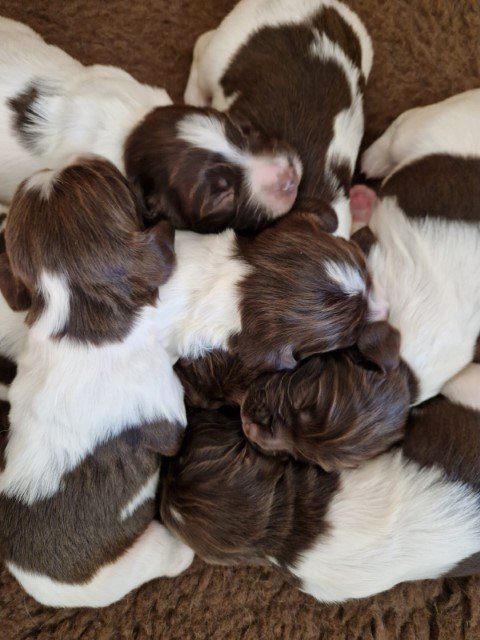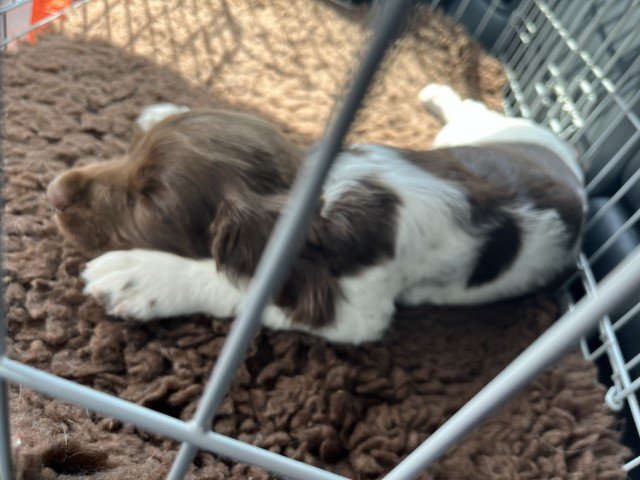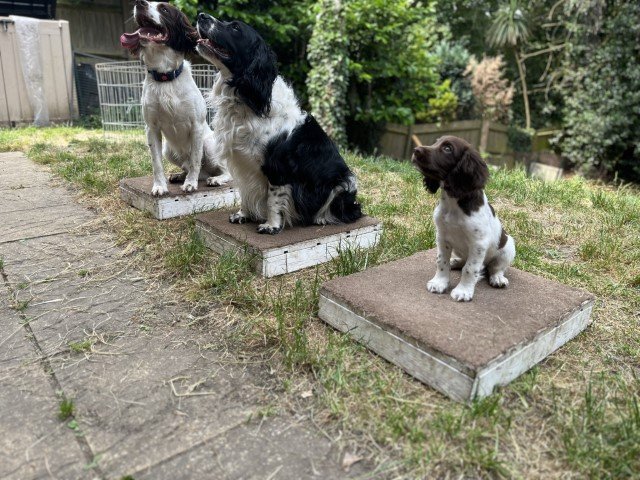Your New Puppy - The First Three Weeks
Getting a new puppy is a huge step, we have two dogs already and moving to three feels like a big change.
Getting a puppy
I gave up work at the end of February to start my dog training business.
I was already musing about getting a puppy thinking it would be great for the business to record the puppy’s training and working through puppy struggles and would help me be more in tune with my puppy clients.
It became more of a reality when I found out that the breeder who provided one of our older dogs happened to have a litter due.
Choose a good breeder
It was lovely to watch the pups grow in the updates that the breeder sent.
We didn’t meet our puppy until the day we collected him as we already knew the breeder, but of you are dealing with a breeder for the first time it is recommended you visit at least once before deciding on having a pup.
We met our puppy’s mother and siblings, and his father visited, so we have lovely photos of the family group.
It is recommended that you always see your pup with Mum and litter mates but this was the first time I was lucky enough to meet Dad too.
After some paperwork, we officially welcomed little Flash to our family.
Taking our puppy home
On the journey home, Flash was in a crate on the back seat.
He was very settled, we travelled the three and a half hours home in one go and when we got home he went straight out into the garden and did a wee!
That night, he settled and slept well, he was in a small dog crate by my bed, and when he woke, I took him outside and he did a wee and settled straight back to sleep.
Over the next two weeks, he woke up twice at night to wee, night time trips to the garden are accompanied by at least one of my other dogs but we keep it low key and it hasn’t developed into night time antics.
Early puppy training
There have been many things that I wanted to get right with Flash, one of the most important was having a puppy that could settle but I think he has already read the instruction manual!
When popping a puppy into a dog crate or puppy pen, it is important to consider whether all their needs have been met; could they be hungry, thirsty, need the toilet?
If these needs haven’t been met, we are not setting them up for success and it is unlikely they will settle.
Sometimes it can be difficult to be sure; there are a couple of pointers which have helped me with Flash.
The first has been, that if he is whining, to observe him for a few moments, whining seems to be part of his settling process and does not mean he needs anything, if he looks calm and comfortable, I give him time to fall asleep.
This has helped me to not bring him out of the crate unnecessarily.
If the whining is accompanied by agitation and restlessness, then he may need something, a trip to the toilet or a drink, for example, in which case, I would bring him out of the crate.
I have tried hard to get this right because a puppy will soon pair whining with getting let out of the crate which can lead to more whining.
I also try to initiate releasing him from the crate, i.e. not waiting for him to whine or ask to come out.
Puppy Play
Flash likes his toys and will play happily in his pen or crate.
He remains settled with all the comings and goings of deliveries and visitors, he is fine with the vacuum cleaner, and even if he does get disturbed usually manages to settle himself.
This is a really useful skill and helps puppies realise that they do not need to be involved in every activity, some things that happen are none of their business!
If puppy understands this and is content to spend time sleeping or awake playing in a crate or pen, this is an important step in preventing struggles related to being left alone.
Introducing a Puppy to other Dogs in the Home
We are a multi-dog household and we already have gates on internal doors and stairs, and dog crates, so it is easy to create a safe space for each individual dog.
Puppies can be annoying to older dogs, play fighting and biting ears, and they have to learn how to interact appropriately, so it is important that access is supervised.
It is not fair on an older dog to expect them to put up with a puppy.
If this behaviour is allowed to continue unchecked, one of the older dogs could get cross and make a bad decision leading to harm.
Puppy Biting
On occasion, Flash has been prone to biting and nipping, more so than any previous puppy I have had, there may be several factors contributing to this, possibly hunger, teething, and over-stimulation.
Activities which cause him to become excited seem to trigger biting, I have made a point of keeping these interactions very short, maybe just a couple of minutes and then settling him again.
He has a variety of chew toys, such as a rope toy and some teething toys, occasionally he has also had a small carrot from the fridge to chew, this helps soothe the gums, as would a Puppy Kong stuffed with boiled mashed vegetables.
I have selected puppy toys which are appropriate for his size, and he is supervised when playing.
Toilet Training the Puppy
Toilet training is going well, Flash gets the opportunity to toilet at least every hour and more frequently if he is showing signs he may need to go.
We don’t wake him up to toilet - we encourage him to be happy toileting on different surfaces which is really useful if you are away from home.
We have a verbal cue to toilet which is useful if you need to go on a journey and you want your dog to toilet before they get in the car or attend a training group.
Crate Training your puppy
Crates can be really useful in the first few months of having a new puppy.
A crate is a safe place, like a den, and should be comfortable and welcoming, a place where your puppy will choose to hang out.
Covering the crate can be useful in helping puppy to settle.
Having the radio or television on in the background can also help puppy to settle.
Why use a dog crate for your puppy?
Using a crate helps ensure the pup gets enough rest and sleep, most need about 18 to 20 hours a day, and can help with toilet training.
A crate can help pup settle on their own and learn to be independent.
Having a dog that is able to settle in a crate is also very useful if they need to spend time at the vet’s.
Crates are often used as a safe space for travel.
A dog will settle much more easily and cope with a potentially stressful situation, if they are already happy in a crate.
A dog crate is never used as a punishment.
It’s important to introduce your puppy to the crate in the correct way.
Encouraging pup to enter the crate of their own accord by placing some of their daily food allowance or some treats in the crate will help them understand that it is a good place to be.
You can get puppy used to having the door closed by closing it briefly and rewarding pup well with the door closed and then opening it.
Rewarding when the door is closed helps pup associate the closed door with good things and helps them feel comfortable.
My experience with crate training
Lex, my english springer spaniel, had surgery at 13 months old and, due to complications which occurred after surgery, had a period of crate rest which lasted for 3 months.
Initially, he really did not like the crate at all and we used high value food, mainly chicken, that he really liked, to get him used to the idea.
It was well worth the effort because he was able to settle happily in the crate during his recovery.
We still have the dog crate and he chooses to go in there sometimes to relax and snooze.








